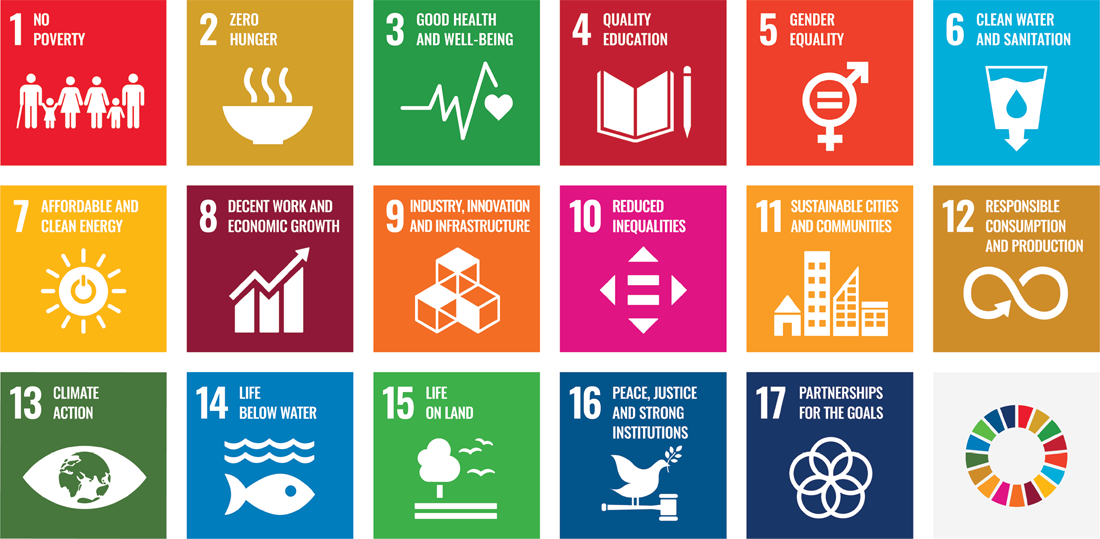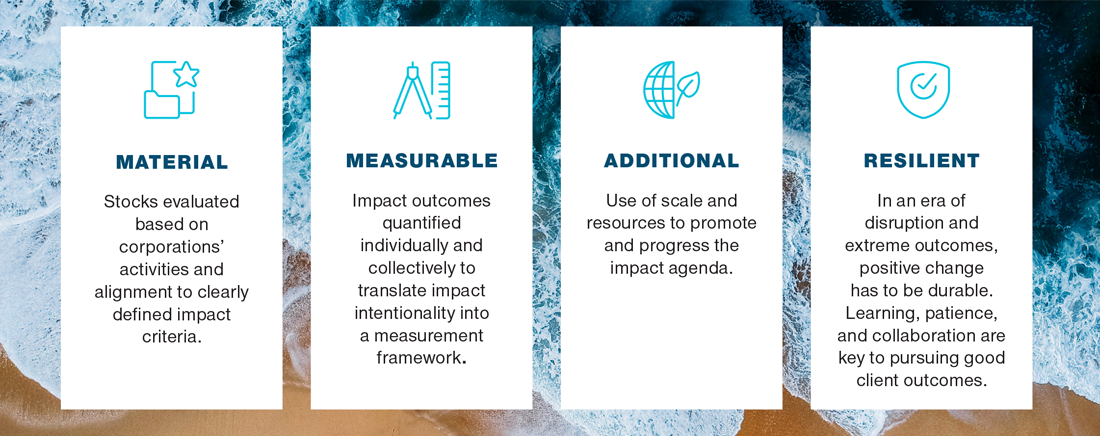April 2023 / INVESTMENT INSIGHTS
Fostering Change With Impact Investing
Pursuing social and environmental impact alongside financial returns
Key Insights
- Our dual mandate is to identify companies that are successfully driving positive impact while also seeking outperformance. We believe those companies have a greater likelihood of delivering higher topline growth over time.
- We are searching for the winners that are leading the charge and putting our capital behind those that are accelerating the move toward positive outcomes.
- If we can deliver financial returns and measurable impact, we believe most investors will choose that over financial returns alone. That means more investors interested in investing in impact and more companies following our lead.
Impact investing has gained traction in recent years to address the needs of investors seeking a more values‑based investment approach. We brought together our three impact portfolio managers to discuss the rise of impact investing and how they see the sector evolving.
Q. Why is impact investing important? What qualifies as an impact investment?
David Rowlett (DR): I have always seen investing as playing an important role in society—delivering long‑term financial performance to help our clients meet future needs, such as education and retirement. When you add steering capital to companies that are helping to address some of the world’s most important environmental and social issues, it makes that capital allocation all the more important. In pursuit of this, we use the United Nations Sustainable Development Goals (UN SDGs) as our North Star. These are a set of 17 goals, intended to help achieve a better and more sustainable future for all. Every one of our investments needs to be aligned to at least one of those goals (see Figure 1).
United Nations Sustainable Development Goals (UN SDGs)

The trademarks shown are the property of their respective owners.
Source: United Nations.
Matthew Lawton (ML): I would highlight the sheer amount of investment required to achieve those goals. The UN estimates that USD 5–7 trillion in investment is required per year through to 2030 to meet its goals, and entire sectors such as utilities and autos need to transition energy use to reach net zero by 2050. As impact investors, we need to allocate capital to those companies and projects that are driving that positive change.
Hari Balkrishna (HB): In terms of the investment process and what qualifies as an impact investment, we are aligned on our goal of providing investment strategies that can deliver positive environmental and/or, social impact alongside a financial return. In identifying impact investments, our process begins with our Impact Charter. We use either revenues or profits to define impact and evaluate whether a company’s revenues or profits are delivering impact that is material to its business model and aligned with one of our impact pillars or sub‑pillars.
The second criteria we look for is measurability. We use our well‑defined framework (Five Dimensions of Impact) to measure the future impact that investments can potentially deliver over time and review annually the total impact achieved. The third aspect is additionality. Can we make a difference due to our involvement? This is primarily through stakeholder engagement and working with companies to influence debate around the delivery of impact. For example, we have worked with multi‑industrial companies to discuss how they can direct M&A capital toward positive impact activities, and water infrastructure companies to help introduce water‑safe targets. The final part of our process is the resilience angle: working to help ensure that the impact identified is durable.
Our Impact Charter
Four key elements of our impact approach

For illustrative purposes only.
As of April 2023.
Source: T. Rowe Price
Q. Do you have to sacrifice financial returns to achieve impact?
DR: We believe there can be an inherent tailwind by investing in the right companies that are working to solve the problems the world is facing today. But qualifying as an impact stock does not necessarily mean it is going to be a great investment. There will be many that work in the right industries but don’t have a good business model and will fail.
Our dual mandate is to identify companies that are successfully driving positive impact while also seeking outperformance. We believe such companies have a higher likelihood of delivering higher topline growth over time. We want to find the winners that are leading the charge and put capital behind those accelerating the move toward positive outcomes. With the size, resources, and expertise at T. Rowe Price, we believe we have an advantage in finding those companies.
ML: I think we have a shared belief that those companies that are helping to solve for the world’s environmental and social pressure points will have an advantage from a capital markets perspective, from a competitive perspective, and then, ultimately, from an economic returns perspective.
Defining and Targeting Positive Impact
Impact pillars and sub-pillars

For illustrative purposes only.
As of April 2023.
Source: T. Rowe Price.
Q. What differentiates impact from responsible, sustainable, and ESG investing?
ML: The term environmental, social, and governance (ESG) is often thrown around liberally and, perhaps, is not as universally understood as you may think. ESG is not an investing style, but more of a capability. Beyond ESG integration, there are exclusionary approaches that exclude certain sectors or companies from a portfolio because they are perceived to be harmful to the planet or society. Positive tilt or sustainable investing builds upon those exclusions with a commitment to invest a portion of the portfolio into sustainable securities.
Impact investing is distinct in that it aims to pursue measurable, positive social or environmental impacts alongside a financial return. Those two objectives sit in equal priority to each other. As an impact manager, we also aim to direct capital to what we believe are the right companies while also ensuring that we measure our investment through impact‑oriented key performance indicators (KPIs) that we record, document, and measure progress over time.
HB: I would add that responsible, ESG, and sustainable investing typically take a more inward‑looking approach when looking at a company’s operations. For example, if you are invested in a health care company, impact investors look at the company’s own carbon emissions or its treatment of employees. Impact investors are more focused on what is the external impact of those operations on our planet and society.
Q. How do public and private investing compare in the impact discussion?
HB: Public equity and debt markets are integral to meeting the challenges we face. We referenced earlier the estimated USD 5–7 trillion of investment needed every year to meet the UN SDGs, and we believe that, without the participation of large publicly listed companies, it will be extremely difficult to achieve those targets.
The debate between public and private investing typically goes beyond the scale of the potential impact because, clearly, publicly listed companies have huge scale. The focus centers on additionality and whether, as impact managers, we can improve the impact delivered from our investments. Ultimately, we are looking to provide capital to companies that we believe are engendering change. But we also have deep, strategic engagement with publicly listed companies to bring impact issues to the forefront, and we use our proxy voting rights to push that forward.
ML: We have worked with companies that are early in their impact journey and have helped them to identify impact projects with accompanying KPIs. We have also guided them on how to structure their social bonds to help maximize impact potential. This evidences a viable pathway to make an impact through public debt markets.
DR: This is not a competition, as both public and private investors are striving to achieve impact. We do have the added benefit of additionality, but we need all types of investment capital to help meet these environmental and social goals.
Q. How do you address the recent cynicism around impact/ESG/sustainability investing? Do you worry about “greenwashing,” or even “green hushing,” with companies increasingly being scrutinized over their impact credentials?
DR: There has been increased cynicism around ESG, and impact investing has mistakenly been included in that conversation. There is also increased confusion around what ESG means and a misunderstanding as to the role that ESG plays. It can often be misconstrued as meaning that it is a green investment vehicle, when it just means that you are taking ESG factors into consideration. Impact investing is much clearer and more defined. It’s focused on outcomes, and we are investing in companies that are working toward solving one or more of the 17 UN sustainable development goals. If your business does not meet the criteria to help achieve one of those goals, then it doesn’t fit in with our impact mandate.
HB: I would agree that impact investing is one of the best ways to express ESG intentions. Traditional ESG looks at environmental, social, and governance issues from a risk perspective, but impact investing is far more in depth and focused. We have also seen incidences of poor quality of data and, in some cases, false claims being made by companies and asset managers who run ESG funds that don’t necessarily stick to their mandate. This is where the benefits of active impact investing and deep fundamental research may bring rewards to help meet the standards that investors are seeking. Ultimately, our mandate is to solve for the sustainable development goals while making investments that have positive financial characteristics. In the same way that investors invest in a subset of a market, such as growth or value or dividend yield, we believe impact investing should be viewed as its own category.
ML: On the concept of greenwashing, it is an unfortunate issue for both issuers and asset managers. For example, there are certain energy companies that claim their businesses are aligned with 16 of the 17 UN SDGs, but that obviously merits scrutiny. On the asset manager side, we welcome the increased scrutiny as it will help shine a light on those who are relabeling their funds as “ESG” for marketing purposes. However, if regulation becomes too overbearing and prescriptive, then it may have unintended consequences. For example, if there were requirements to define what is and isn’t a sustainable investment, that might be overly rigid in our view. There is also an unintended risk that companies may end up backing away from embracing sustainability if they are fearful of being called out for greenwashing. What is important is that an impact manager stays true to the impact principles of materiality, measurability, additionality, and resiliency.
Q. What does the future hold for impact investing?
ML: From a fixed income perspective, we are very excited about the future as the market is growing every day. In 2022, we had USD 1.5 trillion of green, social, and sustainability bond issuance. That now stands at USD 5.9 trillion and continues to grow.1 That is important because, as new companies and sectors come to the ESG bond market to finance environmental and social projects, it creates more opportunities for investors to make an impact. It also presents additional alpha opportunities alongside greater portfolio diversification potential.
Looking at the bigger picture, there is also a secular element as we believe impact investing offers a clear and differentiated solution for investors seeking to be on the right side of change. Over time, we believe investors will think about impact investing as a complement to the core building blocks that compose a diversified asset allocation approach.
HB: When we think about future success, it will be twofold. If more clients can see the value and benefits of impact investing in terms of delivering positive impact alongside positive financial performance, then more money will be allocated to the space. We also hope it crystallizes the objectives of companies as they think more along the lines of impact investors to help make their operations more sustainable and impactful.
DR: At T. Rowe Price, we are trying to be at the forefront by developing a better model and approach to impact investing. If we can deliver financial returns and measurable impact, we believe that the category itself is positioned to grow dramatically. That means more investors interested in investing in impact and more companies following our lead. That can create a flywheel effect that moves us toward our goal of focusing companies on the large and pressing environmental and social issues facing us today. If we are successful in our mission, we believe we can open a category and invite more investors to participate. It is our firm belief that if you can achieve financial returns while creating impact, then most investors will choose that over financial returns alone.
IMPORTANT INFORMATION
This material is being furnished for general informational and/or marketing purposes only. The material does not constitute or undertake to give advice of any nature, including fiduciary investment advice, nor is it intended to serve as the primary basis for an investment decision. Prospective investors are recommended to seek independent legal, financial and tax advice before making any investment decision. T. Rowe Price group of companies including T. Rowe Price Associates, Inc. and/or its affiliates receive revenue from T. Rowe Price investment products and services. Past performance is not a reliable indicator of future performance. The value of an investment and any income from it can go down as well as up. Investors may get back less than the amount invested.
The material does not constitute a distribution, an offer, an invitation, a personal or general recommendation or solicitation to sell or buy any securities in any jurisdiction or to conduct any particular investment activity. The material has not been reviewed by any regulatory authority in any jurisdiction.
Information and opinions presented have been obtained or derived from sources believed to be reliable and current; however, we cannot guarantee the sources' accuracy or completeness. There is no guarantee that any forecasts made will come to pass. The views contained herein are as of the date noted on the material and are subject to change without notice; these views may differ from those of other T. Rowe Price group companies and/or associates. Under no circumstances should the material, in whole or in part, be copied or redistributed without consent from T. Rowe Price.
The material is not intended for use by persons in jurisdictions which prohibit or restrict the distribution of the material and in certain countries the material is provided upon specific request.
It is not intended for distribution to retail investors in any jurisdiction.
April 2023 / ASSET ALLOCATION VIEWPOINT




